As winter deepens and chills, many of our breeding songbirds are sunning themselves in sub-Saharan Africa. However, though fewer in number, equally interesting passerines arrive in Britain to spend the winter, and perhaps the most charismatic are three species associated with the coast: Shore Lark and Lapland and Snow Buntings. Of these, only the last is truly a British bird, breeding sparsely in the highlands of Scotland, but wintering in substantially higher numbers as birds arrive from both Iceland and the Continental Eurasian Arctic in autumn to eke out a living among the shingle and sand.
Snow Bunting Plectrophenax nivalis has been present in Britain for up to 120,000 years. Fossil bones have been attributed to this species from Late Devensian Pleistocene deposits in Pinhole Cave on the border of Derbyshire and Nottinghamshire, alongside those of Demoiselle Crane, Tengmalm's Owl and Alpine Swift.
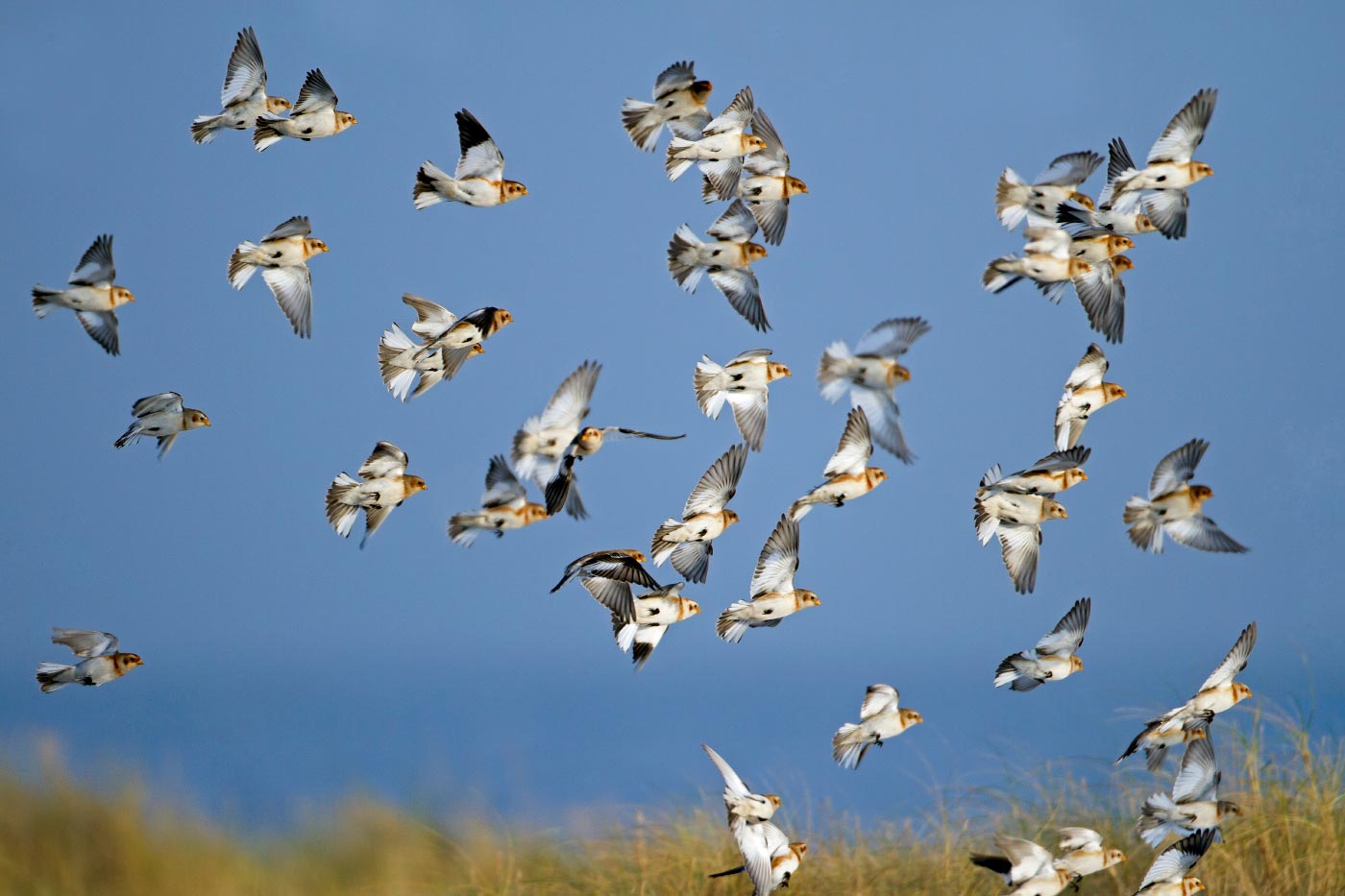
Snow Buntings arrive in Britain from the Arctic in autumn in numbers, and come from both the north-west in the case of Icelandic birds and the north-east in the form of Fennoscandian nesters. The two subspecies both also breed in tiny numbers in highland Scotland (Colin Smale).
Britain's tiny relict breeding population of 60 pairs hides a dual identity. These barely sustainable numbers – Snow Bunting is expected to be driven out by climate change and is currently Amber-listed for Conservation Concern due to a recent decline – include representatives of two different subspecies spread thinly across the Cairngorms and north-west Highlands. There are greater numbers of the Icelandic insulae, with a few of the nominate nivalis peppered among them and more prevalent in the former region. This eastern and western bias of the two subspecies is almost certainly due to their origin in the core range of their mother forms.
Autumn arrivals
The scarcity and restricted range of the species in summer is dwarfed by the annual influx of both subspecies from north-east and north-west in winter. It is also conceivable that the north-eastern European to north-west Siberian subspecies vlasowae occurs, though there are as yet no confirmed records on the British list. The fourth and final form townsendi is only found on the Aleutian, Commander and Pribilof island groups between Alaska and Russia.
No longer treated as a bunting despite its name, Snow Bunting is now considered a 'longspur' along with Lapland Bunting. Together the two species form their own family Calcariidae in a separate New World (and now circumpolar) lineage from the true buntings. This close relationship has been partly confirmed by the recent observation of a hybrid between Lapland and Snow Buntings on Newfoundland, Canada, in April 2011.
Snow Bunting is supremely adapted for a polar lifestyle, not just with the different variations of its black, white and brown plumage, but also physiologically. Usually seen either flying over or habitually running around on the ground, it is a robust seedeater about the same size as Corn Bunting, with a 'bodybuilder's chest' and often fluffed-up plumage. Despite its restlessness, it is not particularly flighty and can be approached at sometimes very close quarters.
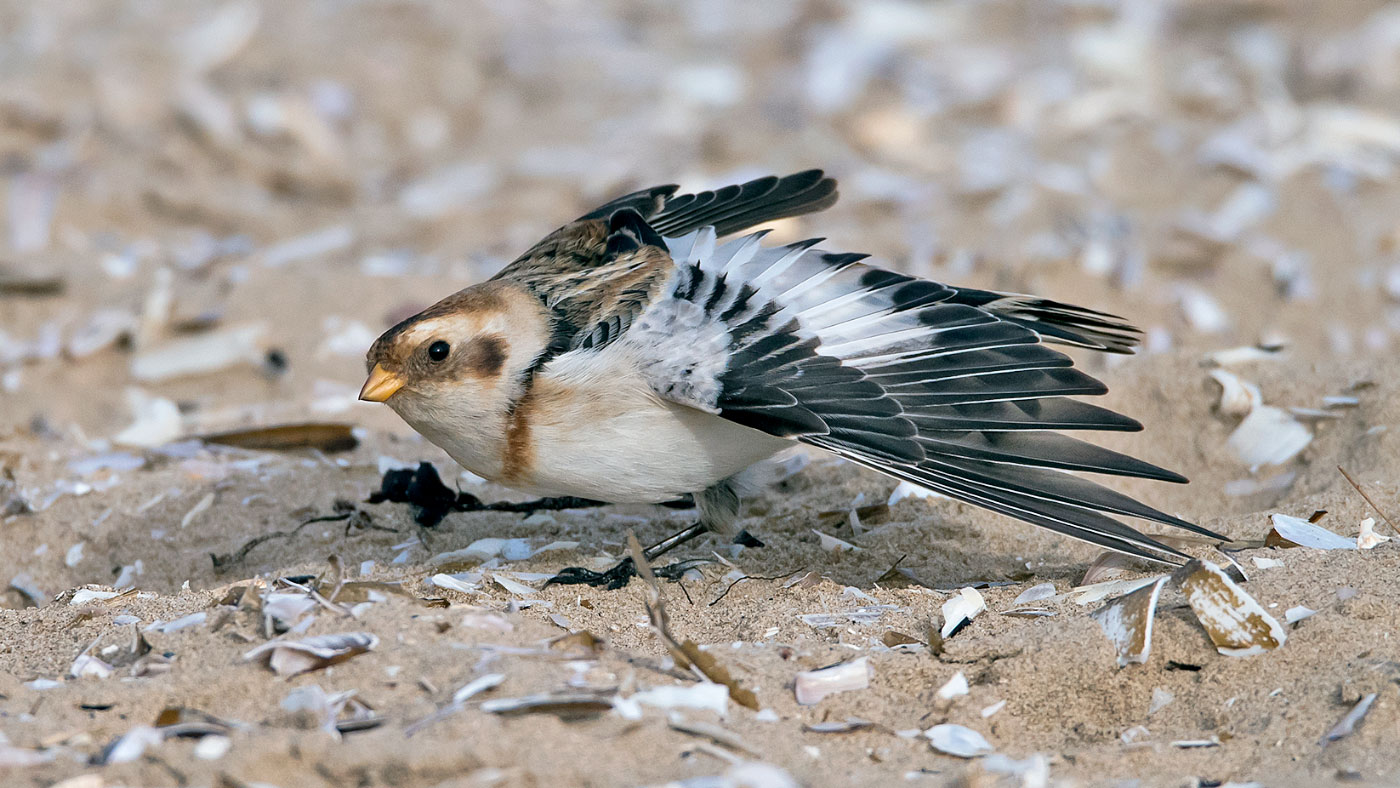
Female Snow Buntings are not as monochrome black and white as the males, but dark mantles are intermixed with black and brown feathers. They still show two large white patches on the lesser coverts and secondaries (Steve Young / birdsonfilm.com).
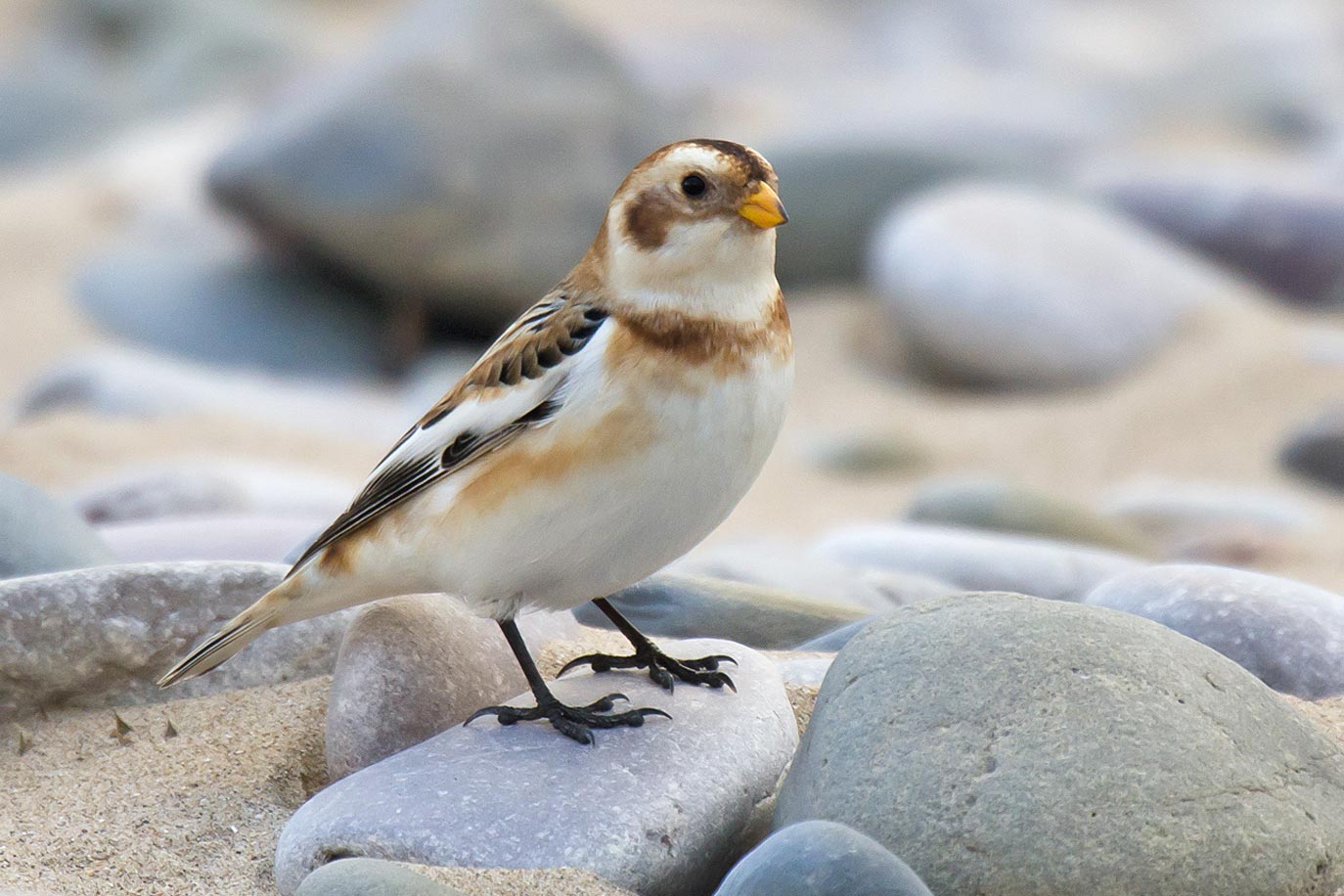
Winter males are subtly different to females, with their pastel orange-buff tones and large white wing patches which create a striking black-and-white pattern in flight. The bill turns pale orange in both sexes in the cold months (Steve Young / birdsonfilm.com).
Summer males are strikingly black-and-white birds, particularly when 'worn in' at the height of the breeding season – fresher birds can have a buff tinge. The black bill, eye, legs, wing-tips and tail centre contrast with the white inner wings, large wing patches, tail sides and body; only the mantle is streaked and brown tinged. Winter males have mostly moulted in their streaky orange-buff upperparts by the time we see them here, though they are still quite pale in comparison to the dull streaky grey-brown upperparts of summer females and overall mid-brown of winter females, again streaked. Males are also larger and bulkier and are able to survive at higher latitudes in winter, and altitude seems to directly affect the gender composition of wintering flocks. Juveniles are a streaky grey with an obvious white eyering, and are perhaps at their most bunting-like in this garb. The black bill turns yellow with a dark tip come winter, somewhat like Twite.
The differences between the four subspecies are subtle. These mostly involve the colour of the fringing on the upperparts and the amount of black on the rump, flight feathers and wing coverts, with insulae being the darkest and vlasowae the palest.
In the lengthy shallow undulations of its flight, Snow Bunting intersperses frantic fluttering troughs with closed wing peaks, while uttering a distinctive rippling call, reminiscent of Crested Tit, punctuated by a Little Ringed Plover-like peeuu, at a quicker pace than the fairly similar calls of Lapland Bunting. Its vocabulary is more varied on the breeding grounds, and there is a simple song and some hoarser alarm and irritation calls. Bio-acoustic analysis of singing males in Canada has shown that though Snow Bunting's song is fairly simple, it exhibits much variation and each individual male has its own song, which can also change each year. It is likely that females are able to judge each male's fitness from these variations, but we are not sure how as yet.
A truly Arctic passerine, Snow Bunting has a circumpolar distribution throughout the boreal and Arctic regions, preferring treeless, flat, dry habitats at the edge of snow and ice for breeding, sometimes on outcrops (nunataks) in glacial fields or occasionally among seabird colonies on cliffs or even in towns beyond the treeline.
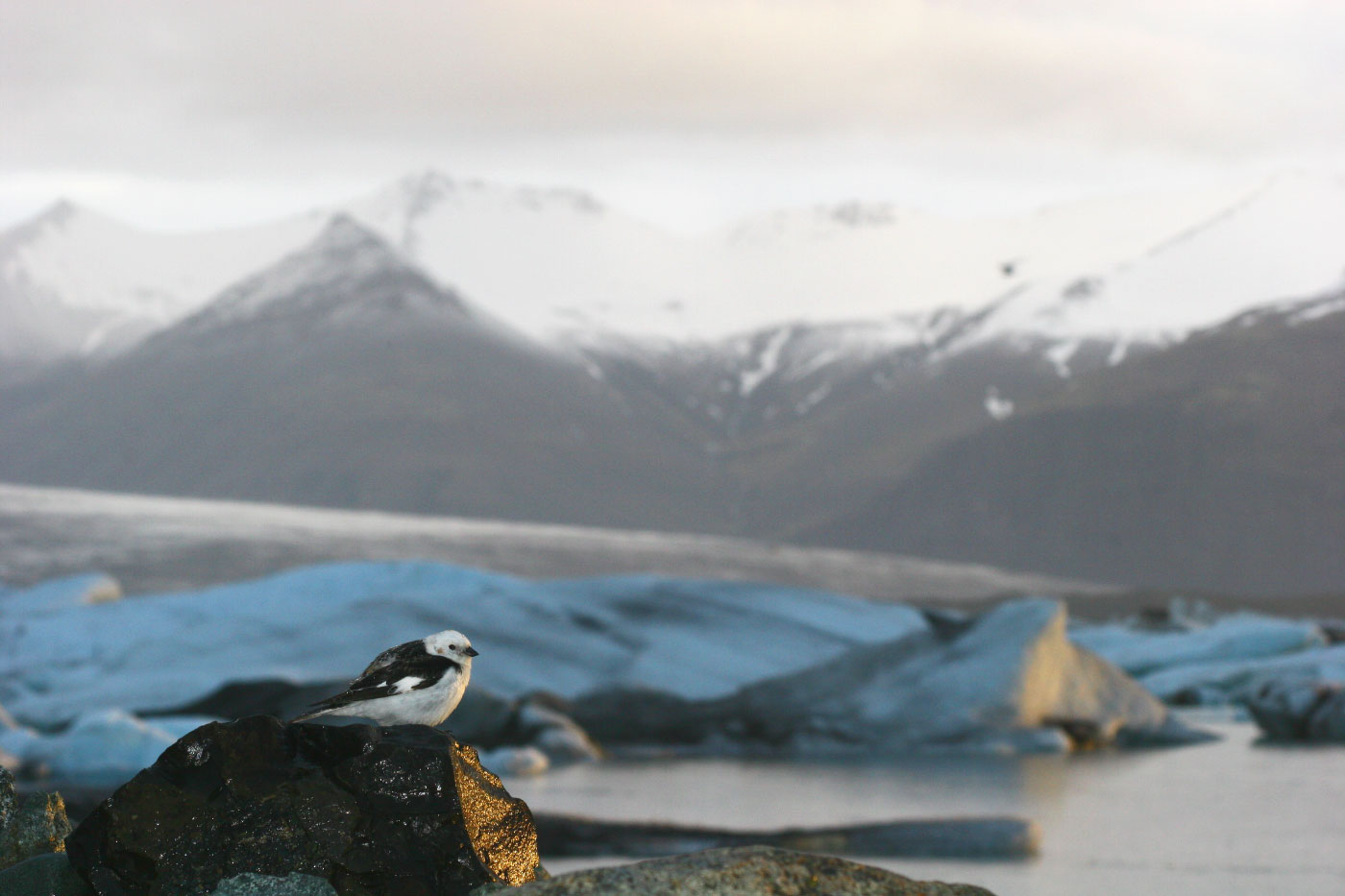
An adult male surveys its bleak nesting territory in Iceland. Despite the apparent lack of plants and food, Snow Buntings often subsist on insects and plant matter blown into areas above the snowline, which are then mired in the snow and ice (Menno van Duijn / www.agami.nl).
As breeding is timed for the Arctic thaw, the clutch of about four-five eggs is not laid until early June on average. A Snow Bunting pair is largely monogamous, though males in particular are known to cheat on occasion. If the 'mistress' is already looking after a first brood, these are often left to die, though the male may continue to feed his own first brood. The species is very territorial, and in more usual circumstances a pair will jointly raise their young. The nest itself is usually in a crevice or in the shelter of a boulder near vegetation, and may even be up to a metre underground or within a substrate.
The nest is very feathery, but has a base of lichen, moss and grass. The eggs are bluish and patterned with brown or black blotches. They are incubated for 12-13 days, and the resulting chicks fledge within two weeks, but are able to catch their own flies within four or five days. Owing to the isolation of the nests and consequent lack of predation, fledging success is about 75 per cent, substantially higher than most other bird species.
As might be suspected, Snow Bunting largely eats seeds, but adds high-energy and protein-rich invertebrates to the menu during the breeding season, like most other seed-eating birds. Its success among the snowfields is mainly due to the large numbers of small insects which are carried up the mountains or into the tundra by the wind, which then become immobilised on patches of snow.
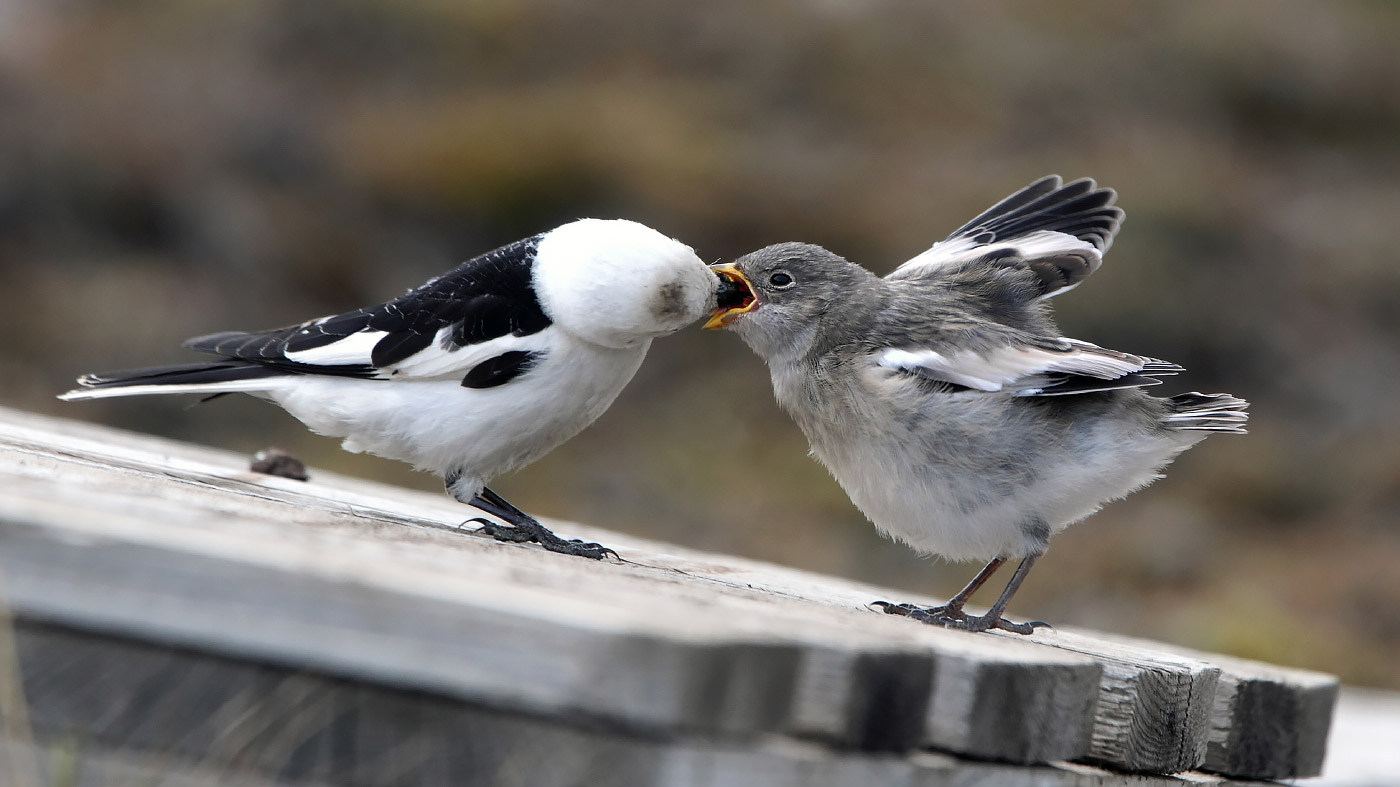
Both males and females help raise their chicks; here an adult summer male is placing insects in the throat of its hungry, stubby-tailed youngster during the short-lived Spitszbergen spring in the Norwegian Arctic (Tony Clarke).
After breeding, birds can disperse singly or in flocks, though as a whole the species is rather gregarious. Groups containing just juveniles become nomadic in the natal area before migration, but flocks seen on winter territories are often of mixed ages and sexes. On migration through Central Asia and Russia, birds can be seen at woodland edges, roadsides and crop fields. In western Europe the main wintering areas are pebbly or sandy beaches, arable areas and adjacent weedy ground, or on upland moors unless the weather has been overly harsh and forces them lower.
Highland peaks
In Britain, most of our wintering birds come from Iceland, but more southern records in late winter are often found to be nivalis birds of Scandinavian origin. The species' strong tolerance of snowy conditions means that many of our own breeding birds stay put in the Highlands.
Wintering flocks usually number up to 25 individuals, but an exceptional flock of about 1,500 was recorded in Orkney in 1984, while an April flock of around 10,000 was once recorded at Hailuoto, Finland. Sometimes larger flocks are formed with other finch species, Lapland Buntings or Shore Larks, and occasionally even Eurasian Skylarks and Fieldfares. Birds generally roost in holes and crevices among rocks and in walls, and occasionally in trees or long grass. Like Shore Lark, Snow Bunting will sometimes burrow into snow to roost or loaf, while snow is also occasionally used for bathing.
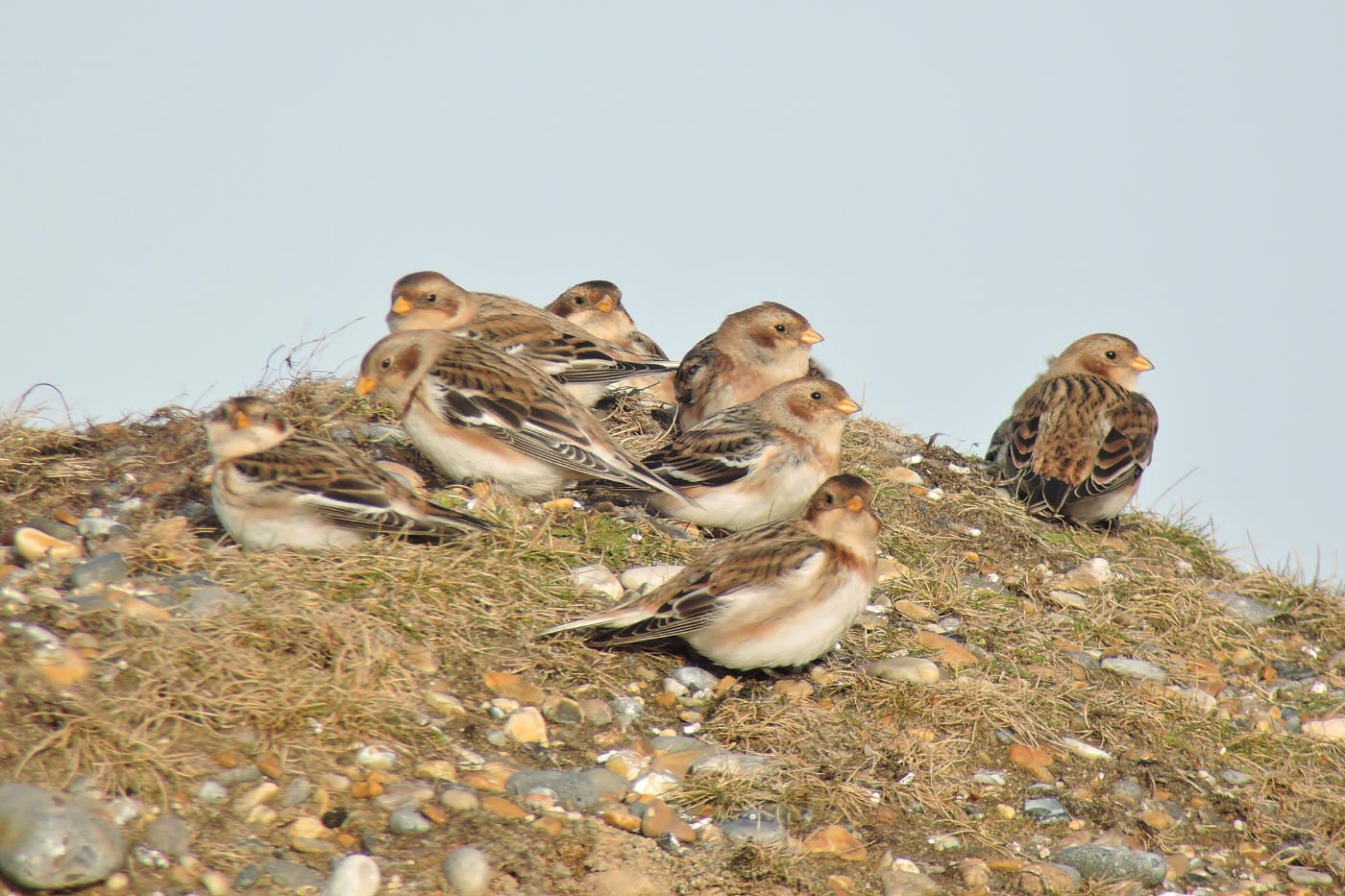
A non-breeding flock in perhaps their most typical British coastal habitat of a shingle beach, in one of the best places to see wintering birds: north Norfolk. There has been a 34 per cent increase in British overwintering birds – particularly in upland areas – and this is possibly another signifier of climate change (Denise Rendall).
At home in the polar regions, the species' activities are controlled by circadian rhythms – regular 24-hour cycles controlled by hormones rather than light sensitivity. Evidence for this is provided by observations of a population in Svalbard, Norway, in Longyearbyen valley, which is in near-permanent shadow apart from an hour or so around midnight. The birds still sleep at midnight, just like those that live on the open tundra in summer.
Despite Snow Bunting's deep adaptations to the harsh polar wastes, it is not free from vulnerability. Local climatic conditions can have an adverse effect on breeding success, as can the Arctic Oscillation (AO) – the fluctuating changes in weather and temperature resulting from sea-level atmospheric pressure, which is closely tied in with the North Atlantic Oscillation. If the AO is going through a positive phase, earlier, warmer springs and cooler, more humid summers follow, resulting in Snow Buntings breeding earlier and mistiming their hatch with the peak of the summer insects they need to ensure a healthy survival rate of fledglings.
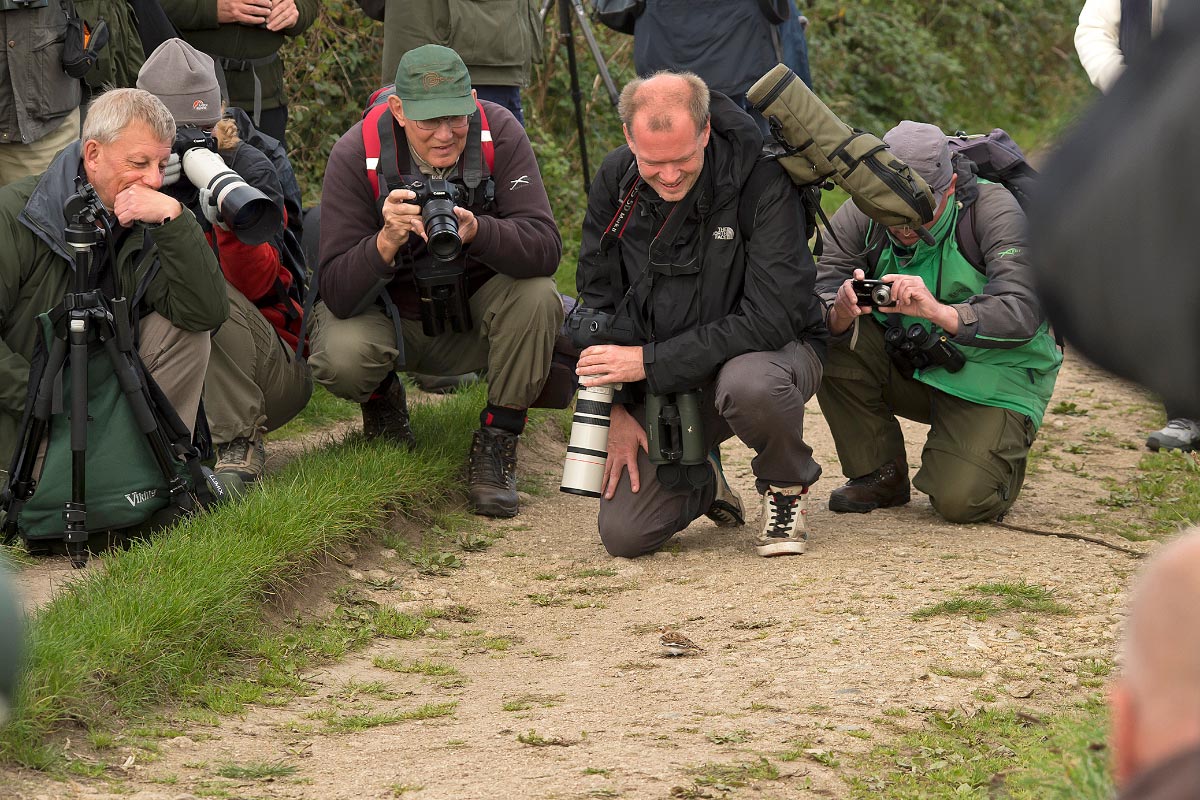
Migrant Snow Buntings can be remarkably confiding, such as this bird on Penninis Head, St Mary's, Scilly, in October 2012, making many of the photographers' lenses redundant (Steve Young / birdsonfilm.com).
The AO index tends to fluctuate between positive and negative historically, allowing redress, but over the last four decades it has maintained a positive trend due to warmer global average temperatures. As temperatures escalate, Snow Bunting will have less breeding success, while competitive bird species will also arrive on its territories. While better survival of second broods later in the summer may also be a consequence, the overall trend is likely to be downward.
Such trends will have a direct effect on the species in Britain, and modelling predicts that its range will contract and it will then probably vanish from its Highland haunts in the near future if current climate trends continue or worsen. While montane zones may retain some snow cover, it is probable that there simply won't be enough left to sustain a healthy Snow Bunting breeding population; these trends are mirrored in other specialist birds of the uplands such as Ring Ouzel, Eurasian Dotterel and Ptarmigan.
It is saddening to think that the traditional birders' long weekend away to see the 'Scottish specialities' may be a thing of the past in just a few decades' time, which should be incentive enough to pay the Cairngorms a visit next spring.
However, it is likely that the bulk of the birds will continue to migrate to our beaches for a lot longer. The winter months are your chance to experience this for yourself. Why not head out into the autumnal chill and be charmed by a flock's bubbling and squeaking calls soon.
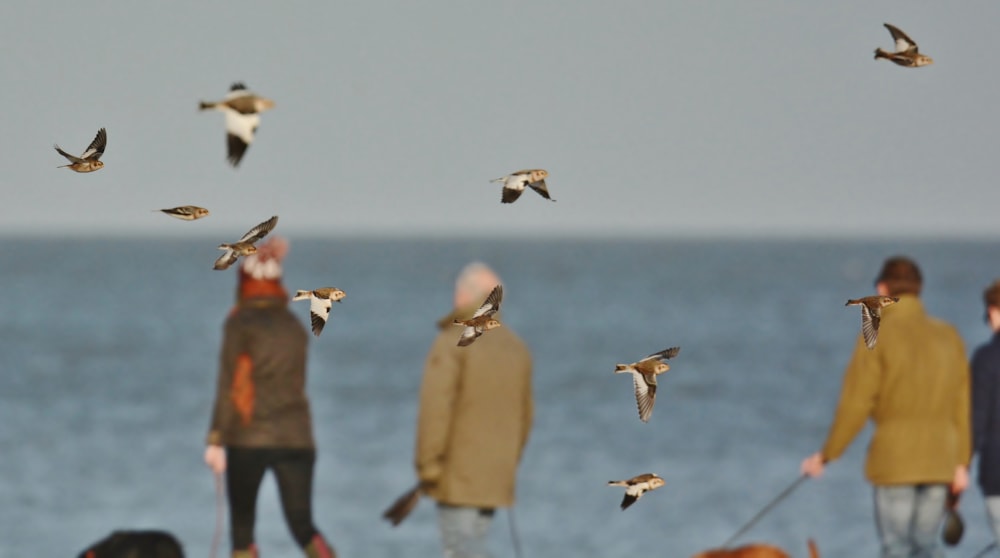
Snow Bunting will likely remain a familiar winter visitor to our coasts, even if a warming climate leads to the extirpation of the tiny population breeding in Scotland (Mick Davis).
References
Baldo, S, Mennill, D J, Guindre-Parker, S, Gilchrist, H G, and Love, O P. 2014. Snow buntings sing individually distinctive songs and show inter-annual variation in song structure. The Wilson Journal of Ornithology 126: 333-338.
Balmer, D E, Gillings, S, Caffrey, B J, Swann, R L, and Fuller, R J. 2013. Bird Atlas 2007-11: the Breeding and Wintering Birds of Britain and Ireland. BTO Books, Thetford.
BirdGuides. 2008. BWPi 2.0. BirdGuides, London.
Crick, H Q P. 2004. The impact of climate change on birds. Ibis 146: 48-56.
Fossøy, F, Stokke, B G, Kåsi, T K, Dyrset, K, Espmark, Y, Hoset, K S, Wedege, M I, and Moksnes, A. 2015. Reproductive success is strongly related to local and regional climate in the Arctic Snow Bunting (Plectrophenax nivalis). Polar Biology 38: 393-400.
Kehoe, C. 2006. Racial identification and assessment in Britain: a report from the RIACT subcommittee. British Birds 99: 619-645.
Klicka, J, Zink, R M, and Winker, K. 2003. Longspurs and Snow Buntings: Phylogeny and biogeography of a high-latitude clade (Calcarius). Molecular Phylogenetics and Evolution 26: 165-175.
Krüll, F, Demmelmeyer, H, and Remmert, H. 1985. On the circadian rhythm of animals in high polar latitudes. Naturwissenschaften 72: 197-203.
MacDonald, C A, Martin, T, Ludkin, R, Hussell, D J T, Lamble, D, and Love, O P. 2012. First Report of a Snow Bunting x Lapland Longspur hybrid. Arctic 65: 344-348.
Ryzhanovsky, V N. 2015. Comparative Ecology of Horned Lark Eremophila alpestris flava Gm. and Snow Bunting Plectrophenax nivalis L. in Subarctic and Arctic Zones. Contemporary Problems of Ecology 8: 309-316.
Smith, R D. 1994. Snow Buntings Plectrophenax nivalis: the Behavioural Ecology and Site Use of an Itinerant Flock Species in the Non-breeding Season. PhD thesis, Department of Zoology, University of Glasgow.
Smith, R D. 1996. Racial composition of breeding and wintering Snow Buntings Plectrophenax nivalis in the north-east Scottish uplands. Ringing and Migration 17: 123-136.
Yalden, D W, and Albarella, U. 2009. The History of British Birds. Oxford University Press, Oxford.
blx1.bto.org/birdfacts/results/bob18500.htm.


